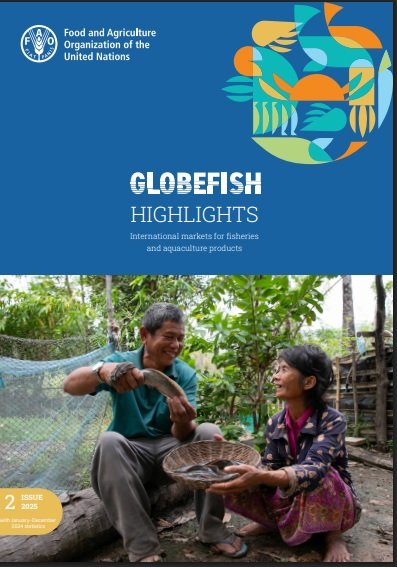
The global fisheries and aquaculture sector is preparing for a 2025 full of contrasts. While total production continues on an upward trajectory, driven almost entirely by robust aquaculture, the commercial landscape faces significant headwinds due to persistent inflation and a readjustment in global tariff policies. The latest “GLOBEFISH Highlights” report from the FAO, with consolidated data from 2024, paints a complex picture where resilience and adaptation will be key for producers and exporters.
Below, we break down the most important findings of this fundamental study to understand the present and future of our sector.
A global landscape with macroeconomic challenges
The economic optimism from the beginning of 2025 has cooled. The International Monetary Fund (IMF) adjusted its world growth forecast for 2025 downward, setting it at 2.8%. The main reasons are the new tariff measures established by the U.S. and inflation that refuses to yield in advanced economies. This translates into two major challenges for the sector: restrictive monetary policies that weaken consumer spending and more complex international trade.
A clear example is the introduction in April 2025 by the United States of a universal 10% ad-valorem tariff on all imports, with even higher rates for selected partners and products. This measure has already prompted signals of retaliation from major trading partners, leading the World Trade Organization (WTO) to revise its 2025 projection from modest expansion to a 0.2% contraction.
In this context, the global trade of aquatic products is projected to see a modest increase of 1.7%, reaching 183.8 billion dollars, although the volume will barely grow by 0.5%.
Aquaculture, the undisputed engine of growth
Despite the complex economic scenario, the total production from capture fisheries and aquaculture will reach 196.6 million tonnes in 2025, a 1.5% increase over the previous year.
The main driver of this growth continues to be aquaculture. It is expected to reach 104 million tonnes, representing a solid increase of 2.6%. Meanwhile, capture fisheries will remain practically stable, with a slight increase of 0.3% to 92.6 million tonnes. This stability in wild-catch fishing is due to opposing dynamics: while larger catches of Alaska pollock and Argentine Illex squid are expected, quota cuts for Barents Sea cod and Mediterranean hake will offset these gains.
Analysis by species: A market of highs and lows
The FAO report reveals that market behavior varies enormously by species, reflecting a diversity of challenges and opportunities.
Salmon: Stable production but under pressure
During 2024, global Atlantic salmon production remained stable at 2.8 million tonnes. Norway, the main producer, faced challenges such as higher taxes, sea lice, and algal blooms. In Canada, the industry in British Columbia is facing a transition to phase out open net-pen farming by 2029, creating uncertainty about future production. Chile, for its part, saw a 9.5% decrease in its production in 2024, dealing with high sea temperatures.
Shrimp: The Ecuadorian giant slows down and Asia reconfigures
The meteoric expansion of shrimp production in Ecuador has paused, affected by weak prices and local energy problems. This has caused global production to stagnate. In response, some producers in South and Southeast Asia are pivoting to the cultivation of black tiger shrimp, a higher-value species, albeit in lower volumes. Globally, shrimp imports fell by 1.6% in volume in 2024.
Pangasius and tilapia: Two opposing freshwater stories
The pangasius sector in Vietnam shows great dynamism, with a forecasted 7% harvest increase in 2025, reaching 1.65 million tonnes. This increase will boost frozen fillet exports. On the other side of the coin is tilapia in China, where a price slump to below 1.04 USD/kg has forced processors to reduce production. This scenario opens opportunities for other tilapia producers like Brazil, whose exports to the United States are set to double, also benefiting from relatively low tariffs.
Capture fisheries and their products: Between quotas and recovery
Capture fisheries also show divergent trends. The recovery of the Peruvian anchoveta, with a quota of 3.0 million tonnes for the first season of 2025 (the largest since 2018), has stabilized the supply of fishmeal. However, low oil yields are keeping that market tight.
On the other hand, high-value species like Norwegian cod face a 31% quota cut in the Barents Sea, which has raised the price of frozen fillets to 13 USD/kg. This has encouraged greater substitution with Alaska pollock, which has benefited from higher quotas in the Gulf of Alaska.
Conclusions for the aquaculture sector
The GLOBEFISH 2025 report paints a clear picture: the aquaculture sector is not immune to global economic and geopolitical turmoil. Consumer demand, affected by inflation, and the reconfiguration of trade routes due to new tariffs are factors that will define profitability in the coming months.
Aquaculture is reaffirmed as the pillar of growth in the supply of seafood products, but the sustainability of this growth will depend on the ability of producers to innovate, diversify markets, and manage costs in an increasingly unpredictable environment. Adaptation, both in production techniques and commercial strategies, will be more crucial than ever.
Reference (open access)
FAO. 2025. International markets for fisheries and aquaculture products – Second issue 2025, with January–December 2024 statistics. GLOBEFISH Highlights, No. 2-2025. Rome. https://doi.org/10.4060/cd5809en
Editor at the digital magazine AquaHoy. He holds a degree in Aquaculture Biology from the National University of Santa (UNS) and a Master’s degree in Science and Innovation Management from the Polytechnic University of Valencia, with postgraduate diplomas in Business Innovation and Innovation Management. He possesses extensive experience in the aquaculture and fisheries sector, having led the Fisheries Innovation Unit of the National Program for Innovation in Fisheries and Aquaculture (PNIPA). He has served as a senior consultant in technology watch, an innovation project formulator and advisor, and a lecturer at UNS. He is a member of the Peruvian College of Biologists and was recognized by the World Aquaculture Society (WAS) in 2016 for his contribution to aquaculture.
